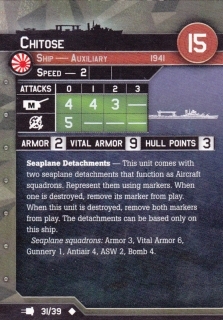War at Sea
Allied Nations
- Australia
- Brazil
- Canada
- France
- Greece
- Netherlands
- New Zealand
- Norway
- Poland
- Soviet Union
- United Kingdom
- United States
- Allies stat table
Axis Nations
Neutral Nations/Installations
Sets
- War At Sea
- Task Force
- Flank Speed
- New Starter
- Condition Zebra
- Set V (Fleet Command)
- Surface action
- First Strike (Forumini Expansion Deck A)
- Infamy (Forumini Expansion Deck B)
- Battle Line (Forumini Expansion Deck C)
- All Hands on Deck (Forumini D)
- Action Stations (Forumini E)
- Dead Reckoning (Forumini F)
Unit Card:

Set - Rarity - Number
V - Uncommon - 31/39
History:
RB's Opening Salvos #3 (updated by nrnstraswa)
During the interwar years, naval aviation evolved in two distinct branches: carrier-based aircraft designed to launch and recover from a flight deck, and seaplanes that could fire off a catapult rail or take off and land from any reasonably calm stretch of water. Seaplane carriers (sometimes referred to as seaplane tenders, although that usually meant a ship intended to serve as a mobile base for large flying boat aircraft) were ships designed to carry a large contingent of floatplanes that could serve as scouts, bombers, and even fighters. By the beginning of World War II most seaplanes were at a significant disadvantage in performance as compared to non-floatplanes, but they were still very useful for scouting, patrol work, and providing light ground support or air cover. A seaplane carrier could provide an instant airbase in an area where it might take weeks or months to build an airstrip, and free up conventional aircraft carriers for more important work.
Chitose and her sister Chiyoda were Japan’s first purpose-built seaplane carriers, built during the mid-30s. Chitose played an active role in the early months of the war, providing air cover and ground support for several landings in the Philippines and East Indies, including Legaspi, Davao, Bangka, Menado, Kendari, Batavia, and Halmahera. She sailed as part of the invasion group in the Battle of Midway, and her floatplanes shot down a PBY that discovered the force. Chitose was badly damaged by dive bombers during the Battle of the Eastern Solomons (24 August 1942), but continued to serve in the Solomons until January of 1943, when she returned to Japan for conversion into a conventional light aircraft carrier. She eventually met her end during the Battle of Leyte Gulf (25 October 1944).
Chitose’s aircraft included the F1M2 “Pete,” E13A1 “Jake,” and A6M2-N "Rufe While the Pete was no Zero or Val, it could serve as a fighter, scout, or a bomber at need. The Rufe, on the other hand, was actually the seaplane version of the Zero, and was the best floatplane fighter of the war.
Reviews:
RB's Opening Salvos #3
Chitose is essentially an unarmored light cruiser with the firepower of a middling destroyer. Don’t be deceived by its unglamorous stats—her Seaplane Detachments special ability provides you with two functional squadrons that are included in Chitose’s 15-point cost. The seaplane squadrons won’t kill many enemy warships or shoot down many planes, but they are excellent for harassing submarines, threatening lone destroyers, and chasing off fragile enemy aircraft such as PBY Catalinas or Swordfish. Most importantly, the seaplane squadrons help you to gain control of the aircraft mission phase by giving you a couple of expendable “units” you can use early in aircraft placement.
Kazuhisa
Ahh the Chitose. How many in my group have learned to hate it. Though 2 ASW is not much of a threat to most subs, being able to deploy every turn makes them very dangerous. The 4 bomb attack can threaten all destroyers and even the odd cruiser here and there. Excellent for taking up air placement, they can help prevent opponents air cover from protecting the right ships. 6 vital armor actually makes them surprisingly long lasting, especially if sent against weaker destroyers. Once all air units are gone though, you basically just have an expensive destroyer with 3 hull and no torps.
anonymous
In my experience, you can use the Chitose for an air placement advantage…for 1 turn. Say that you do use the seaplane squadrons to trick your opponent. First turn you place a seaplane detachment over a carrier, and your opponent places a Hellcat in response. Second turn you put your second seaplane detachment over the carrier, and your opponent places another Hellcat there. Then you place the rest of your aircraft over a battleship, and you chuckle and say "Ha ha! That was my real target all along." Then your opponent chuckles as that carrier and the two hellcats blast your seaplanes out of the sky. You can use them like this, but they're only good for one turn that way. I prefer to always place the seaplanes last—commit your regular airpower while your opponent does likewise. Then when you're both probably out of planes, you get two free placements with the seaplanes to harass subs or take runs at destroyers. Your seaplanes will last a lot longer that way, and in my experience you get a lot more benefit from them this way than using them as a 1-turn air placement advantage.
Aran55633
15 points for a destroyer (with 3 hull points and no torpedoes) and two anti-destroyer, submarine-harassing aircraft capable of flying every turn… That's a pretty good deal.
GreyFox78659
This ship is a sub harasser plain and simple don't use her for anything else. She is worth the points if you use her right but don't waist her seaplanes on a hard target unless there is no other options available.
Plastic Figure Notes:











